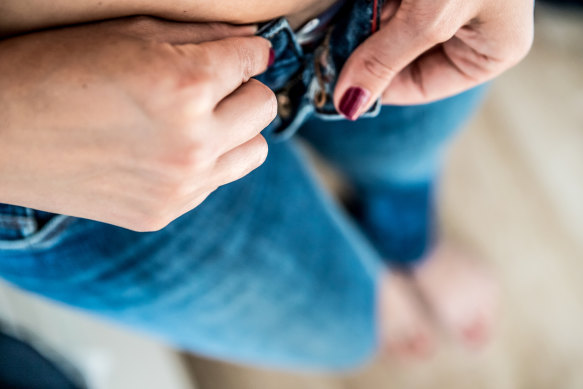‘Bracketing’ and refund abuse: Why we’re hooked on returning clothes
If you’ve ever shopped for a dress or pair of pants online and, in a moment of doubt, panic or indecision, bought multiple sizes – and returned all but one, or everything – you may be guilty of “bracketing”.
Retailers use this term for the hedging behaviour employed by shoppers that is influenced by several factors, including free shipping and returns, inconsistent sizing, and buyers’ remorse.
It’s also a behaviour the chief executive of The Iconic, Jere Calmes, would love to see gone from online shopping.

Trying on at home is a gift of online shopping, but it leads to more returns.Credit: iStock
“You have to offer returns, or else people wouldn’t buy online,” he says. “It’s a necessary part of trading. [Our focus is on] how you do it, what are the terms, what is being returned and why?”
The online shopping boom has given rise to an explosion in the number of returns that is problematic for retailers, the environment and consumers, who, many say, are the ones who ultimately pay through higher prices.
Described by some experts as “retail’s biggest unaddressed problem”, returns can be a hassle for consumers if they aren’t handled smoothly. But if brands’ policies are too generous, it can lead to abuse.
Calmes, who took over The Iconic last year, is working to reduce the company’s returns rate – currently about 30 per cent. But, he says, it needs to be a two-sided effort: retailers need to provide the best information and service, so customers can make sound, responsible purchases.
“If a customer is [bracketing], what they’re saying is they don’t know the size they need,” he says.
Then there are serial returners and returns fraudsters, who include “wardrobers” – people who wear an item once, most often to an event, then return it. In extreme cases, these shoppers may have their accounts suspended. But these are all in the minority, Calmes says.
What is on the rise are returns of expensive items, driven by cost-of-living remorse, he adds. “There’s a very high correlation – the more expensive a product, the higher the return rate,” he says.

Returns warrior: The Iconic chief executive Jere Calmes.
“There’s a sustainability angle that really we need to do something about. And … you can also look at this from the perspective of just putting a business together. This [returns] is one of our biggest costs.”
Do ‘free’ returns really exist?
Australians buy more clothing per head of population than any other country in the world – 56 items per year, based on latest data. So it follows that we also return a sizeable chunk of that.
Across all retail, the average rate for returns is 17 per cent. Focus on fashion, and that number rises to 30 per cent, or roughly one in three garments purchased.
In the US, retail returns rose from $US308 billion ($459.7 billion) in 2019, to $743 billion ($1.1 trillion) in 2023. There is no equivalent data for Australia, but according to Australia Post’s annual report on e-commerce, consumers made online purchases worth $63.6 billion last year, meaning the returns value could be as high as $21 billion (based on a returns rate of 30 per cent).
Across all retail, the average rate for returns is 17 per cent. Focus on fashion, and that number rises to 30 per cent.
Given these numbers, it’s understandable why more fashion brands, especially medium to large ones, are outsourcing returns to companies like B dynamic Logistics, which has warehouses in Sydney, Brisbane and Auckland, with plans to expand to Melbourne and Perth.
B dynamic head of growth Adam Quinn says that aside from the lost revenue, returns create costs for businesses because they take about three to four times longer than a sale to process, which includes quality assessment and returning the item to stock, redistributing it, or destroying it if it’s not in a resaleable condition.
Items are only deemed unfit for sale 1.4 per cent of the time at The Iconic, but Quinn says the industry-wide incidence is higher, although there is no data to support this. In the luxury sector, products may be deemed unfit for sale even if the packaging is damaged, adds Quinn.
So does that mean there are $2000 designer bags being sent to landfill because of a broken box? “Yes,” he says.
Quinn says consumers are educating themselves on how to manipulate returns policies in their favour – and sharing the information on TikTok.
“Online retailers are being squeezed by short delivery times and free returns,” he says. “I don’t think [consumers] are considering the impact it has on the retailers or the environment. But, ultimately, they end up paying for it.”
Change of mind? That’ll be $8
More retailers overseas, including Zara Spain, have started charging for returns to help curb abuse. From this month, ASOS customers who regularly keep less than £40 ($78) of their total purchase must pay a returns processing fee of £3.95 ($7.68). For now, it won’t apply to first-time or infrequent returners, or customers who pay an upfront subscription of £9.95 ($19) a year.
In Australia, most major retailers offer free returns, though some require customers to cover the cost of return postage. Others, such as By Charlotte, offer customers incentives such as bonus store credit for reconsidering refunds.
Brisbane venue manager Yazi Stemp says she is happy to pay an upfront fee to avoid returns “bill shock”, especially when shopping with overseas brands. As a plus-size shopper, she says being able to return items with ease is crucial to an enjoyable shopping experience.

Yazi Stemp says online returns are key to her being able to shop with confidence. Credit: Paul Harris
While searching for her wedding dress, Stemp shopped at sites including ASOS and The Iconic. She returned about five or six dresses all up, describing the process as “smooth” and the retailers “super helpful”.
Stemp is happy to pay smaller retailers to return items, but says she would be put off if a bigger company introduced a fee.
“Sizing can be so inconsistent, numerous times I have ordered a pair of pants from a retailer similar to ones I already own … only to find their sizing chart or material has changed,” she says. “I think the onus is on the retailer to help facilitate the return.”
The role of AI in the war on returns
Justin O’Sullivan is the co-developer of tech platform Rewise, which is helping brands reduce their return rates, including through the use of AI.
“Ultimately, the cost of returns is built into the cost of items, and reducing returns will ultimately benefit consumers, businesses and the environment,” he says.
Returns are such an important sustainability issue that Rewise is partnering with the University of Technology Sydney and research hub Rapido to research consumers’ returns behaviour. The goal is to develop machine-learning models that can be applied across industries.
While introducing fees is one way to change consumer behaviour, US retailer Revolve has managed to reduce its refund rate – once as high as 60 per cent – without resorting to charging customers. Kai Li, Revolve’s senior vice-president of international, says by not charging, retailers can gain a competitive advantage. “We believe charging for returns could jeopardise spending by our valued customers over the long term,” Li says.
The Iconic’s Calmes is watching the overseas situation, and says he prefers to reward good customer behaviour than punish bad. Incentives to discourage returns will be rolled into The Iconic’s new loyalty program, which is set to launch next year, although Calmes was as yet unable to provide details.
He would love to see the company returns rate get as low as 10 per cent during his tenure. And not just for reasons of self-interest, or profit.
“We definitely want to reduce returns,” he says. “But we want to do it in a way that customers actually buy into.”
Make the most of your health, relationships, fitness and nutrition with our Live Well newsletter. Get it in your inbox every Monday.